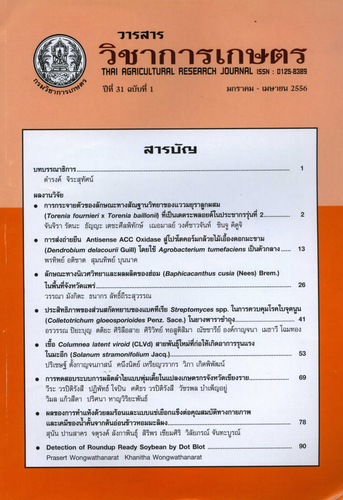ผลของการทำแห้งด้วยลมร้อนและแบบแช่เยือกแข็งต่อคุณสมบัติทางกายภาพและเคมีของน้ำคั้นจากต้นอ่อนข้าวหอมมะลิผง
DOI:
https://doi.org/10.14456/thaidoa-agres.2013.10คำสำคัญ:
น้ำคั้นต้นข้าวอ่อนผง, ทำแห้งแบบเยือกแข็ง, คลอโรฟิลล์, ปริมาณน้ำอิสระ, ทำแห้งด้วยลมร้อนบทคัดย่อ
น้ำคั้นต้นข้าวอ่อนผงผลิตจากวิธีการทำแห้งด้วยลมร้อน (40º และ 60ºซ.) และการทำแห้งแบบแช่เยือกแข็ง เปรียบเทียบการเปลี่ยนแปลงคุณสมบัติทางกายภาพและเคมี (จุดเยือกแข็ง ปริมาณคลอโรฟิลล์เอ บี และทั้งหมด ปริมาณน้ำอิสระ และค่าสี (L*,a*,b*) กับน้ำคั้นต้นข้าวอ่อนสดและน้ำคั้นต้นข้าวอ่อนผงที่ทำละลายแล้ว จากการศึกษาพบว่าการทำแห้งแบบแช่เยือกแข็ง ให้ผลิตภัณฑ์ผลมีคุณภาพดีกว่าผลิตภัณฑ์ที่ได้หลังการอบแห้งด้วยลมร้อน เนื่องจากหลังการทำละลายผลิตภัณฑ์ผงให้คุณสมบัติเทียบเคียงได้กับน้ำคั้นต้นข้าวอ่อนสดซึ่งน้ำคั้นต้นข้าวอ่อนสดมีจุดเยือกแข็งประมาณ -1ºซ. ให้ค่าปริมาณคลอโรฟิลล์ทั้งหมดต่ำสุด (0.080 มก./ก.) และหลังการทำแห้งแบบแช่เยือกแข็งให้ปริมาณคลอโรฟิลล์ทั้งหมดเพิ่มขึ้นในช่วง 0.910-0.900 มก./ก. และแตกต่างอย่างมีนัยสำคัญทางสถิติ กับกรณีการทำแห้งด้วยลมร้อน ซึ่งให้ค่า 0.398ม 0.999 มก./ก. มีอุณหภูมิการทำแห้ง 60ºซ และ 40ºซ ตามลำดับ ในขณะที่ปริมาณคลอโรฟิลล์ทั้งหมดลดลงหลังการทำละลาย (0.116 มก./ม.) ผลิตภัณฑ์ที่ได้มีปริมาณน้ำอิสระ (aw) น้อยกว่า 0.6 ซึ่งเหมาะสมกับคุณภาพของผลิตภัณฑ์อาหารผง การเปลี่ยนแปลงค่าสีของน้ำต้นข้าวอ่อนผงอบแห้งที่อุณหภูมิ 40º และ 60ºซ. มีค่า L* b* และ a* เพิ่มมากขึ้นเมื่อเทียบกันน้ำคั้นต้นข้าวอ่อนสดในขณะที่เมื่ออบแห้งแบบแช่เยือกแข็งค่าสี L* b* และ a* มีแนวโน้มลดลง การศึกษานี้พบว่าหลังการทำละลาย ผลิตภัณฑ์น้ำคั้นต้นข้าวอ่อนหอมมะลิผงที่ผ่านการทำแห้งที่อุณหภูมิต่ำทั้งแบบลมร้อน 40ºซ และการทำแห้งแบบแช่เยือกแข็งสามารถรักษาปริมาณคลอโรฟิลล์ และคุณภาพของสีได้ไกล้เคียงกับน้ำคั้นต้นข้าวอ่อนสด
ดาวน์โหลด
เผยแพร่แล้ว
รูปแบบการอ้างอิง
ฉบับ
ประเภทบทความ
สัญญาอนุญาต
ลิขสิทธิ์ (c) 2017 วารสารวิชาการเกษตร (Thai Agricultural Research Journal)

อนุญาตภายใต้เงื่อนไข Creative Commons Attribution-NonCommercial-NoDerivatives 4.0 International License.
วารสารวิชาการเกษตร



